| |
WHITE-EYES Zosteropidae |
- 125 species in Old World tropics
- DR personal total: 39 species (31%), 9 photo'd
|
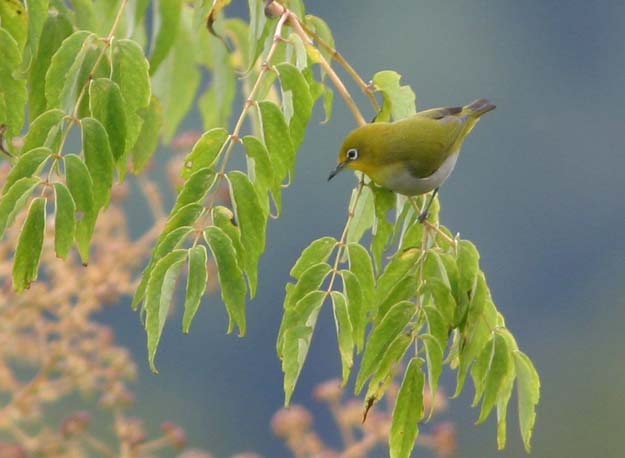 The White-eyes are an old, traditional family. The 'traditional' white-eyes were mostly homogeneous, Old World tropical
group of small arboreal birds. The name comes not from a white iris,
but from a white-feathered ring that is a prominent feature around a
dark eye of otherwise plain little green birds. Some white-eyes are montane
specialists, as is the Mountain White-eye (left) on
the Philippines. On larger Philippine islands, three
species of white-eyes divide up elevational zones. Where that occurs,
this species is always at the highest elevation. The White-eyes are an old, traditional family. The 'traditional' white-eyes were mostly homogeneous, Old World tropical
group of small arboreal birds. The name comes not from a white iris,
but from a white-feathered ring that is a prominent feature around a
dark eye of otherwise plain little green birds. Some white-eyes are montane
specialists, as is the Mountain White-eye (left) on
the Philippines. On larger Philippine islands, three
species of white-eyes divide up elevational zones. Where that occurs,
this species is always at the highest elevation.
|
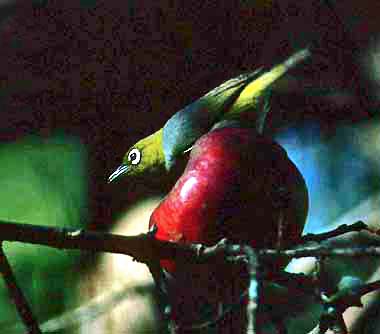 Some
other standard characters of these white-eyes include a brush-tipped tongue for feeding on nectar
(along with insects), semi-pendant nests, and (where known) pale blue
or white eggs (Coates 1990). But genetic evidence showed that white-eyes, such as this Silver-eye
(right, shown eating a crab-apple on Heron I. which is part of
Australia's Great Barrier Reef), were also "babblers" in the broad
sense. Alström et al. (2006) would apparently combine all the
obvious babblers with the Sylvia warblers, the white-eyes, the
parrotbills, and the Wrentit of the New World to form one huge
Timaliidae Family. Under that approach, the family would have about 390
species. Jønsson & Fjeldså (2006) took a different
approach. They divided this huge group into two "clades" [evolutionary
lineages] that are each others closest relatives. If one were to assign
Family rank to each "clade," there would be the Babbler Family
[Timaliidae] of ~340 species, which included the White-eyes, and a
second Family that includes the Sylvia 'warblers', the Wrentit, various
babblers, and almost all of the parrotbills (also once considered a
separate family). A growing consensus (e.g., Cibois et al. 2010),
grounded in the work of Gelang et al. (2009), proposes to split
Babblers into five families. One of these is the Zosteropidae again,
with ~125 species. Some
other standard characters of these white-eyes include a brush-tipped tongue for feeding on nectar
(along with insects), semi-pendant nests, and (where known) pale blue
or white eggs (Coates 1990). But genetic evidence showed that white-eyes, such as this Silver-eye
(right, shown eating a crab-apple on Heron I. which is part of
Australia's Great Barrier Reef), were also "babblers" in the broad
sense. Alström et al. (2006) would apparently combine all the
obvious babblers with the Sylvia warblers, the white-eyes, the
parrotbills, and the Wrentit of the New World to form one huge
Timaliidae Family. Under that approach, the family would have about 390
species. Jønsson & Fjeldså (2006) took a different
approach. They divided this huge group into two "clades" [evolutionary
lineages] that are each others closest relatives. If one were to assign
Family rank to each "clade," there would be the Babbler Family
[Timaliidae] of ~340 species, which included the White-eyes, and a
second Family that includes the Sylvia 'warblers', the Wrentit, various
babblers, and almost all of the parrotbills (also once considered a
separate family). A growing consensus (e.g., Cibois et al. 2010),
grounded in the work of Gelang et al. (2009), proposes to split
Babblers into five families. One of these is the Zosteropidae again,
with ~125 species.
However,
the "new" Zosteropidae includes more than just white-eyes (more on
those below). Still, about 80 species (including recent splits), some
64% of of all white-eyes, are placed in the genus Zosterops.
These small birds are often found in chattering flocks moving
through the canopy. Some are common and widespread, but there are a
good many rare or endangered species in the group, including 21 (nearly
a quarter of all species) that were threatened enough to warrant
accounts in Collar et al. (1994). |
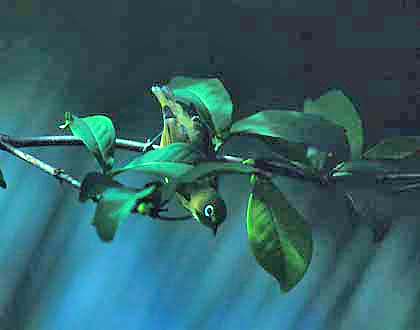 White-eyes
are widely distributed in the Old World, with continental
representatives in Africa, Asia, and Australian, but there are an
inordinate number of island specialties. More than two-thirds of all
white-eyes occur on only rather small islands (excluding New Guinea,
Borneo, Sumatra, Madagascar, and the larger Philippine islands). There
are two white-eyes endemic to tiny Lifou Island in the Loyalties off
New Caledonia, and many species seem to be described in Clements (1991)
like this for the White-throated White-eye Z. meeki: "Uplands of Tagula
Island (off se New Guinea). Status unknown." No wonder I've seen only about a
third of the world's white-eyes! White-eyes
are widely distributed in the Old World, with continental
representatives in Africa, Asia, and Australian, but there are an
inordinate number of island specialties. More than two-thirds of all
white-eyes occur on only rather small islands (excluding New Guinea,
Borneo, Sumatra, Madagascar, and the larger Philippine islands). There
are two white-eyes endemic to tiny Lifou Island in the Loyalties off
New Caledonia, and many species seem to be described in Clements (1991)
like this for the White-throated White-eye Z. meeki: "Uplands of Tagula
Island (off se New Guinea). Status unknown." No wonder I've seen only about a
third of the world's white-eyes!
Many species are isolated on oceanic islands, as is the Caroline Islands White-eye (left), endemic to Truk (Chuuk), Palau & Pohnpei in Micronesia.
When I first visited Micronesia in 1978, the widespread white-eye over
much of the region was considered a single species, the Bridled
White-eye Z. conspicillatus. Thus, when I photographed this
bird (left) on Truk, it was considered just one of the island races of
Bridled White-eye. Now, however, Bridled White-eye has been split into
at least two species and the bird I photographed is known as the
Caroline Island White-eye (Pratt 1987, Sibley & Monroe 1991).
[There is a special irony associated with that decision and this photo.
Years after I visited Micronesia, I purchased, sight unseen, a booklet
called The Native Forest Birds of Guam (Jenkins 1983). Upon opening it, I was shocked to find that my photograph of "Bridled White-eye" (the very same bird shown above top
left) was featured in color on the frontispiece of the publication! No
one had asked my permission to do so, but there it was in living color.
At least they spelled my name correctly and did attribute the bird to
Truk.....but how odd that a species that has never occurred on Guam is
the featured photo in the book on Guam.]
|
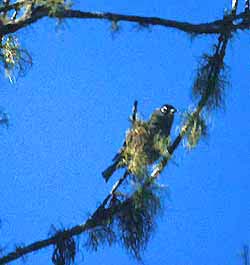 Each
of the islands in the Gulf of Guinea, Africa, has its own endemic: four species of Speirops (a genus that likely should be submerged into Zosterops). Most of the islands in the Indian Ocean have their own white-eye. Some of those
representatives, like the Seychelles White-eye Z. modestus (which I poorly photographed in 1992), have declined during the last
years of the 20th century to endangered status. Others, like the Réunion Olive White-eye (right), are still doing fine. Each
of the islands in the Gulf of Guinea, Africa, has its own endemic: four species of Speirops (a genus that likely should be submerged into Zosterops). Most of the islands in the Indian Ocean have their own white-eye. Some of those
representatives, like the Seychelles White-eye Z. modestus (which I poorly photographed in 1992), have declined during the last
years of the 20th century to endangered status. Others, like the Réunion Olive White-eye (right), are still doing fine.
All
of the white-eyes I've photographed have broad white eye-rings, but a
fair number do not, and sometime go by names such as "Black-eyes." [Chlorocharis in the Philippines is called Blackeye;
Tephrozosterops is called Darkeye]. There is a unique little bird on w. Timor which has been called
Timor White-eye (Clements 1991), Spot-breasted White-eye (Sibley
& Monroe 1991), Spot-breasted Black-eye, Spot-breasted Heleia [IOU], and Timor Ibon.
Barbara Magnuson, who has seen this species with a Ben King tour, tells
me that birds leap-frogged over one another, recalling New World
manakins. It and a related species on Flores are in their own genus (Heleia). Heleia, along with such genera as Rukia in Micronesia, Megazosterops in Palau, Oculocincta on Borneo, and Woodfordia in the Solomons, lack eye-rings. Six species in genus Lophozosterops are also atypical, as are the monotypic genera Apalopteron, Cleptornis, and Madanga.
The DNA evidence places these odd genera in the Zosteropidae (Sibley
& Monroe 1991, Gelang et al. 2009), but most of these taxa are
rather little known. None act like typical white-eyes, and so the word
"White-eye" in their name is misleading. For that reason, Ben King has
suggested the Tagalog word
for "small bird" as an appropriate moniker for the Philippine oddities:
"Ibon." I applaud "Ibon" as a wonderfully coined choice!
The exception to the genetic evidence about the relationship of these odd white-eyes is the case of Cinnamon Ibon Hypocryptadius cinnamomeus
on the island of Mindanao. Fjeldså et al. (2010) showed it was
not related to white-eyes at all; rather, it was a forest canopy
sparrow related to Passeridae! Yet it diverged from its closest sparrow
relatives ~31 million years ago, and I feel it is most consistent to
assign it its own family [Hypocryptadiidae], given the age of its divergence. |
 Genetic evidence (e.g., Gelang et al. 2009) found that all the "babblers" on the Philippines (assigned to genus Stachyris)
were actually more closely related to white-eyes, and these are now
placed in the Zosteropidae. Among them is the spectacular and
endangered Flame-templed Babbler (left), found only on Negros and Panay. It is now placed in genus Dasycrotapha, along with two species of Philippine pygmy-babblers. Genetic evidence (e.g., Gelang et al. 2009) found that all the "babblers" on the Philippines (assigned to genus Stachyris)
were actually more closely related to white-eyes, and these are now
placed in the Zosteropidae. Among them is the spectacular and
endangered Flame-templed Babbler (left), found only on Negros and Panay. It is now placed in genus Dasycrotapha, along with two species of Philippine pygmy-babblers.
Four species of Philippine striped-babblers, plus Chestnut-faced Babbler, are now in genus Zosterornis.
The more widespread and familiar Philippine babblers — Golden-crowned
Babbler, Black-crowned Babbler, and Rusty-crowned Babbler — are now in
genus Sterrhoptilus. |
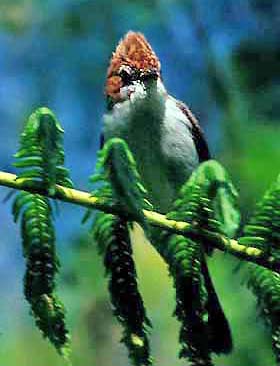 The final 11 species now assigned to Zosteropidae are the yuhinas of Asia (genus Yuhina), ranging from the Himalayas to the Greater Sundas. An example is Chestnut-crested Yuhina
(right), on Mt. Kinabalu on Borneo. Most of the yuhinas resemble
American titmouses in their behavior and short crests, but they are
more colorful. They are small birds, forage in the canopy, and it is
fairly easy to see a relationship to white-eyes. The final 11 species now assigned to Zosteropidae are the yuhinas of Asia (genus Yuhina), ranging from the Himalayas to the Greater Sundas. An example is Chestnut-crested Yuhina
(right), on Mt. Kinabalu on Borneo. Most of the yuhinas resemble
American titmouses in their behavior and short crests, but they are
more colorful. They are small birds, forage in the canopy, and it is
fairly easy to see a relationship to white-eyes.
There is a striking exception in this 'traditional' genus. What was once known as "White-bellied Yuhina Y. zantholeuca" has proven to be most closely related to New World vireos! (Cibois 2003, Alström
et al. 2006). It is now called Erpornis Erpornis zantholeuca. For the moment it is placed among the Vireonidae, but another set of Asian birds, the shrike-vireos (genus Pteruthius)
also have proven to be related to vireos (Reddy & Cracraft 2007).
Yet they diverged eons ago, and I have tentatively placed the
shrike-vireos in their own family. It may be that Erpornis should also
be raised to Family level. More research is needed on all the yuhinas
and the rest of the Asian "babblers." |
| Photos: The Mountain White-eye Zosterops montana was on Mt. Katanglad, Mindanao, Philippines, on 24 Dec 2005. The Silver-eye Zosterops lateralis was eating a crab-apple on Heron I., Great Barrier Reef, Australia, in Sep 1983. The Caroline Islands White-eye Zosterops semperi was photographed on Moen I., Truk Lagoon, Micronesia, on 31 Aug 1978. The Réunion Olive White-eye Z. olivaceus was in the forest above Le Brulé, Réunion I., Indian Ocean, on 4 Dec 1992. Flame-templed Babbler Dasycrotapha speciosa was on Mt. Canloan, Negros, Philippines, on 17 Dec 2005. The Chestnut-crested Yuhina Yuhina everetti was on Mt. Kinabalu, Sabah, Malaysian Borneo, on 5 Aug 1988. All
photos © Don Roberson; all rights reserved. |
Bibliographic notes
There
is no recent "family book" covering the White-eyes but the Handbook of the Birds of the World
account (van Balen 2008) is excellent, with great
photos, although it is not quite up with the most current
taxonomic findings, some of which postdate its publication.
Literature cited:
Alström
P., P.G.P. Ericson, U. Olsson, and P. Sundberg. 2006. Phylogeny and
classification of the avian superfamily Sylvioidea. Molecular
Phylogenetics & Evolution 38: 381-397.
Barker,
F.K., A. Cibois, P. Schikler, J. Feinstein, and J. Cracraft. 2004.
Phylogeny and diversification of the largest avian radiation. Proc.
Nat. Acad. Sci. 101: 11040-11045.
Birdlife International. 2000. Threatened Birds of the World. Lynx Edicions, Barcelona, Spain.
Cibois, A. 2003. Mitochondrial DNA phylogeny
of babblers (Timaliidae). Auk 120: 35-54.
Cibois,
A., E. Pasquet, and T.S. Schulenberg. 1999. Molecular systematics of
the Malagasy babblers (Timaliidae) and Warblers (Sylviidae), based on
cytochrome b and 16S rRNA sequences. Molec. Phylog. Evol. 3: 581-595.
Cibois,
A., M. Gelang, and E. Pasquet. 2010. An overview of the babblers and
associated groups. Systematic Notes on Asian Birds 68: 1-5.
Cibois,
A., B. Slikas, T.S. Schulenberg, and E. Pasquet. 2001. An endemic
radiation of Malagasy songbirds is revealed by mitochondrial DNA
sequence data. Evolution 55: 1198-1206.
Cibois, A. 2003. Mitochondrial DNA phylogeny of babblers (Timaliidae) Auk 120: 35-54.
Clements, J.F. 1991. Birds of the World: A Check-List. 4th ed. Ibis Publishing, Vista, CA.
Coates, B. J. 1990. The Birds of Papua New Guinea. Part II. Dove Publ., Ltd., Alderley, Australia.
Collar,
N.J., M.J. Crosby, and A. J. Stattersfield. 1994. Birds to Watch 2: The
World List of Threatened Birds. Birdlife Conserv. Ser. 4. Birdlife
Intern'l, Smithsonian Inst., Washington, D.C.
Dickinson,
E.C., ed. 2003. The Howard & Moore Complete Checklist of the Birds
of the World. 3d ed. Princeton Univ. Press, Princeton, N.J.
Fjeldså, J., M. Irestedt, P.G.P. Ericson, and D. Zuccon. 2010. The Cinnamon Ibon Hypocryptadius cinnamomeus is a forest canopy sparrow. Ibis doi: 1111/j.1474-919X.2010.01053.x
Gelang,
M., A. Cibois, E. Pasquet, U. Olsson, P. Alström, and P.G.P.
Ericson. 2009. Phylogeny of babblers (Aves, Passeriformes): major
lineages, family limits and classification. Zoologica Scripta 38:
225-236.
Grimmett, R., C. Inskipp, and T. Inskipp. 1998. Birds of the Indian Subcontinent. Christopher Helm, London.
Jenkins, J. M. 1983. The Native Forest Birds of Guam. Ornithol. Monogr. 31. A.O.U., Washington, D.C.
Jønsson,
K.A., and J. Fjeldså. 2006. A phylogenetic supertree of oscine
passerine birds. Zoologica Scripta 35: 149-186.
Keith, S., E. Urban, and C. H. Fry, eds. 1992. The Birds of Africa. Vol. IV. Academic Press, London.
MacKinnon, J., and K. Phillipps. 2000. A Field Guide to the Birds of China. Oxford Univ. Press, Oxford.
Pratt,
H. D., P. L. Bruner, and D. G. Berrett. A Field Guide to the Birds of
Hawaii and the Tropical Pacific. 1987. Princeton Univ. Press,
Princeton, N. J.
Reddy, S., and J. Cracraft. 2007. Old World Shrike-babblers (Pteruthius) belong with New World Vireos (Vireonidae). Molec. Phylog. Evol. 44: 1352-1357.
Sibley,
C. G., and J. E. Ahlquist. 1990. Phylogeny and Classification of Birds:
A Study in Molecular Evolution. Yale Univ. Press, New Haven, CT.
Sibley, C. G., and B. L. Monroe. 1990. Distribution and Taxonomy of Birds of the World. Yale Univ. Press, New Haven, CT.
van Balen, S. 2008. "White-eyes (Zosteropidae)," pp. 402–485 in Handbook of the Birds of the World (del Hoyo, J., A. Elliott & D.A.
Christie, eds). Vol. 13. Lynx Edicions, Barcelona, Spain.
|
|
|

 Some
other standard characters of these white-eyes include a brush-tipped tongue for feeding on nectar
(along with insects), semi-pendant nests, and (where known) pale blue
or white eggs (Coates 1990). But genetic evidence showed that white-eyes, such as this Silver-eye
(right, shown eating a crab-apple on Heron I. which is part of
Australia's Great Barrier Reef), were also "babblers" in the broad
sense. Alström et al. (2006) would apparently combine all the
obvious babblers with the Sylvia warblers, the white-eyes, the
parrotbills, and the Wrentit of the New World to form one huge
Timaliidae Family. Under that approach, the family would have about 390
species. Jønsson & Fjeldså (2006) took a different
approach. They divided this huge group into two "clades" [evolutionary
lineages] that are each others closest relatives. If one were to assign
Family rank to each "clade," there would be the Babbler Family
[Timaliidae] of ~340 species, which included the White-eyes, and a
second Family that includes the Sylvia 'warblers', the Wrentit, various
babblers, and almost all of the parrotbills (also once considered a
separate family). A growing consensus (e.g., Cibois et al. 2010),
grounded in the work of Gelang et al. (2009), proposes to split
Babblers into five families. One of these is the Zosteropidae again,
with ~125 species.
Some
other standard characters of these white-eyes include a brush-tipped tongue for feeding on nectar
(along with insects), semi-pendant nests, and (where known) pale blue
or white eggs (Coates 1990). But genetic evidence showed that white-eyes, such as this Silver-eye
(right, shown eating a crab-apple on Heron I. which is part of
Australia's Great Barrier Reef), were also "babblers" in the broad
sense. Alström et al. (2006) would apparently combine all the
obvious babblers with the Sylvia warblers, the white-eyes, the
parrotbills, and the Wrentit of the New World to form one huge
Timaliidae Family. Under that approach, the family would have about 390
species. Jønsson & Fjeldså (2006) took a different
approach. They divided this huge group into two "clades" [evolutionary
lineages] that are each others closest relatives. If one were to assign
Family rank to each "clade," there would be the Babbler Family
[Timaliidae] of ~340 species, which included the White-eyes, and a
second Family that includes the Sylvia 'warblers', the Wrentit, various
babblers, and almost all of the parrotbills (also once considered a
separate family). A growing consensus (e.g., Cibois et al. 2010),
grounded in the work of Gelang et al. (2009), proposes to split
Babblers into five families. One of these is the Zosteropidae again,
with ~125 species.  White-eyes
are widely distributed in the Old World, with continental
representatives in Africa, Asia, and Australian, but there are an
inordinate number of island specialties. More than two-thirds of all
white-eyes occur on only rather small islands (excluding New Guinea,
Borneo, Sumatra, Madagascar, and the larger Philippine islands). There
are two white-eyes endemic to tiny Lifou Island in the Loyalties off
New Caledonia, and many species seem to be described in Clements (1991)
like this for the White-throated White-eye Z. meeki: "Uplands of Tagula
Island (off se New Guinea). Status unknown." No wonder I've seen only about a
third of the world's white-eyes!
White-eyes
are widely distributed in the Old World, with continental
representatives in Africa, Asia, and Australian, but there are an
inordinate number of island specialties. More than two-thirds of all
white-eyes occur on only rather small islands (excluding New Guinea,
Borneo, Sumatra, Madagascar, and the larger Philippine islands). There
are two white-eyes endemic to tiny Lifou Island in the Loyalties off
New Caledonia, and many species seem to be described in Clements (1991)
like this for the White-throated White-eye Z. meeki: "Uplands of Tagula
Island (off se New Guinea). Status unknown." No wonder I've seen only about a
third of the world's white-eyes! Each
of the islands in the Gulf of Guinea, Africa, has its own endemic: four species of Speirops (a genus that likely should be submerged into Zosterops). Most of the islands in the Indian Ocean have their own white-eye. Some of those
representatives, like the Seychelles White-eye Z. modestus (which I poorly photographed in 1992), have declined during the last
years of the 20th century to endangered status. Others, like the Réunion Olive White-eye (right), are still doing fine.
Each
of the islands in the Gulf of Guinea, Africa, has its own endemic: four species of Speirops (a genus that likely should be submerged into Zosterops). Most of the islands in the Indian Ocean have their own white-eye. Some of those
representatives, like the Seychelles White-eye Z. modestus (which I poorly photographed in 1992), have declined during the last
years of the 20th century to endangered status. Others, like the Réunion Olive White-eye (right), are still doing fine.  The final 11 species now assigned to Zosteropidae are the yuhinas of Asia (genus Yuhina), ranging from the Himalayas to the Greater Sundas. An example is Chestnut-crested Yuhina
(right), on Mt. Kinabalu on Borneo. Most of the yuhinas resemble
American titmouses in their behavior and short crests, but they are
more colorful. They are small birds, forage in the canopy, and it is
fairly easy to see a relationship to white-eyes.
The final 11 species now assigned to Zosteropidae are the yuhinas of Asia (genus Yuhina), ranging from the Himalayas to the Greater Sundas. An example is Chestnut-crested Yuhina
(right), on Mt. Kinabalu on Borneo. Most of the yuhinas resemble
American titmouses in their behavior and short crests, but they are
more colorful. They are small birds, forage in the canopy, and it is
fairly easy to see a relationship to white-eyes.